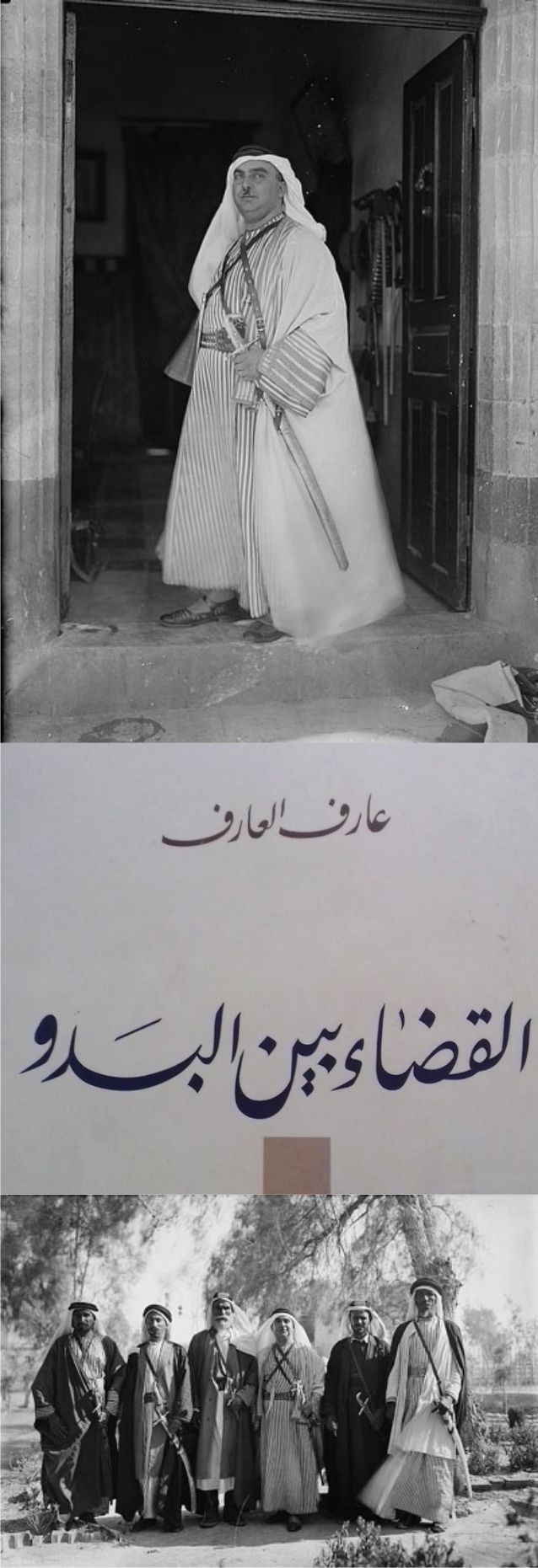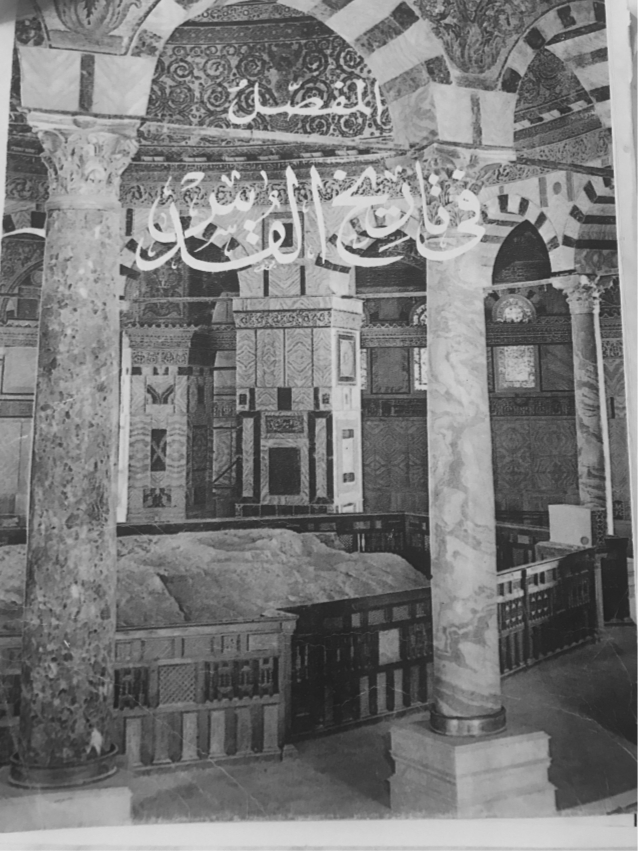Diaries and journals were a prominent feature of daily life among the Jerusalemite Ottoman Arab bourgeoisie at the turn of the nineteenth century and during much of the twentieth century. (Ottoman culture, aesthetics, and values, as well as fluency in the Turkish language, gave the Jerusalemites a distinctive identity known locally as Hamidi, in reference to the era of Sultan Abdul Hamid.) A personal record of events, experiences, thoughts, and observations that formed a discourse with the self was common practice. My father, born in 1892, and a contemporary of Aref al-Aref, has bequeathed to us small booklets in which he had jotted down entries that included detailed price lists of the vegetables he bought, the names of the people he saw, and brief accounts of everyday encounters. The preponderance of this literary discourse is suggestive of a high level of literacy, mental acuity, and culture. Significantly this form of literary expression served as the first draft for the writers who were to flourish during the British Mandate, such as Aref al-Aref, Ishaq al-Husseini, Khalil al-Sakakini, Wasef Jawhariyyeh, and Ihsan Salih Turjman, among others.
When Aref al-Aref assumed his position in 1930 as district administrative officer (قائم مقام) in Bir al-Sabe’(بير السبع – known by its biblical name Beer Sheba), he found himself faced with a conundrum. Righteous, reserved, and pious, he integrated his diary entries into the foreword to his seminal oeuvre, The Bedouin Tribes of Bir al-Sabe’.
From the very first moment in Bir al-Sabe’, I realized that it would be impossible to proceed with my work and resolve the endless disputes among the contentious Arabian tribes without a full understanding of their culture and common practices. I could not discern and judge rightly without knowing their manners and customs. So I started to follow their news, search for their cultural landmarks, and learn to discern their customary laws and practices, what is socially sanctioned to them and what is taboo…
His quests for justice as a district officer among the Bedouins of Bir al-Sabe’ led him to the realization of “justice” as a culture-specific concept and prompted his total immersion as a participant observer in Bedouin tribal life. His research culminated in his classic book The Bedouin Tribes of Bir al-Sabe’, only a few copies of which survive in private libraries. This compendium, whose topics encompass justice among Bedouins as well as their legends, myths, customs, and manners, in addition to the obsolete trial by fire, al-bash’a (البشعه), serves as a main reference work for ethnographers and folklorists.
Historian, journalist, and politician, al-Aref is recognized for his pioneering historical works on Jerusalem, Gaza, and Asqalan (عسقلان, known by its biblical name Ashqelon), his ethnographic work on the Bedouin tribes, and his analytical insights into the Nakba. A long inventory of his pioneering books remains the major reference for any serious student of Palestine. Educated in the best Ottoman tradition, al-Aref rose to great prominence during the British Mandate as district administrative officer in Jenin, Nablus, Beisan, Jaffa, Bir al-Sabe’, and Gaza. During the Jordanian era, he was appointed twice as mayor of Jerusalem, and he was the last Arab director of the Rockefeller Museum.
Aref al-Aref represents the consummate ‘isami (self-made) personality. The adjective ‘isami (عصامي) is a positive term that is often ascribed to the Hamidi generation (named after the Ottoman sultan who ruled from 1876 to 1908) of Palestinians whose exemplary moral fiber, unique visions, indefatigable energy, and charisma account for their great success. The isami was distinguished by the fact that he came from a modest background, had no inheritance to depend on, and worked his way up, dependent on his own merits without the traditional nepotistic mediation. Together with the other pioneers, the children of the effendis and dignitaries from the major Palestinian cities, this generation created the Palestinian Nahda (Renaissance). In Jerusalem this generation includes Dr. Ishaq Musa al-Husseini, Is’afal-Nashashibi, Khalil al-Sakakini, and Tawfiq Canaan, to name a few. Their works formed the nucleus of our modern Palestinian literary library. The loss of Palestine, the Nakba, and the ensuing brain drain stymied their work.
The dynamic vitality of Palestinian culture, whose pioneers forged the path into the twentieth century, is a testimony to the roots of Palestinian modernism in Ottoman culture and values. Western historical narratives on the modern period of Jerusalem are often based on religious myths and Western encounters with the city. This literature has a warped view of Jerusalem, in particular, and Palestine, in general, in which the local Arab Palestinians are marginalized and almost invisible. Though at the beginning of the nineteenth century, Jerusalem was a small provincial center, it is not necessarily true that Ottoman rule was backward and calamitous as has been previously portrayed. If we look at the sources available, most of the accounts that depict Jerusalem as a dreadful place misruled by the “terrible” Turks are, in fact, from Western sources. The modernization of Palestine, contrary to British accounts, did not begin with the British Mandate.
Ottoman reform in Jerusalem, as well as in the rest of Palestine and greater Syria, did not begin with the Ottomans. Modern historiographers trace the history of modernism in Palestine and greater Syria to Mohammad Ali, viceroy of Egypt, who in 1831 conquered and occupied Palestine for nine years by an Egyptian army led by his son Ibrahim Pasha and wrested power from the Ottomans in Egypt, Palestine, and most of Syria. The Egyptian rulers issued a series of reforms, which left a lasting impact on legal and political affairs; these reforms were revolutionary and form the basis of modernization. Law and order were enforced, including maintaining security on the roads – a factor that made Jerusalem and the rest of the country much safer and more accessible to foreign visitors
In 1840 the Ottoman Turks succeeded in driving the Egyptians from the country, with the aid of several European powers, and reinstituted their rule. The returning Turks continued these reforms through a policy known as the Tanzimat. This was designed to allow the Ottomans and all their subjects, including the Turks, to develop the skills necessary to run the economy and society in a modern way and to develop the technology they needed to create modern armies and the economy needed to sustain such forces.
In order to revitalize Ottoman Muslim culture, the educational system and curriculum was completely secularized, and a new secular elite was created. The Ottoman government created schools and universities in Istanbul based on the Western European model. As early as 1891 the Ottoman government opened the first general secondary school in Jerusalem (Rushdiya). All the children of the city, regardless of their religion, could study Arabic, Turkish, French, and the basic sciences. The Tanzimat reforms focused heavily on reforming the Ottoman education system, which had been dominated by the Islamic clerics, but the reforms reduced their influence.
As Ottoman citizens, the Jerusalem-born politicians, writers, and intellectuals – chief among whom stands Aref al-Aref – were the beneficiaries of the modern educational system, which was developed by Sultan Abdul Hamid II. The curriculum generally paralleled the Western model. French and German specialists were even invited to teach in Istanbul’s major colleges. Significantly, the last sultan used his powers as Caliph and opened the doors to children of the less affluent classes, giving them an opportunity to compete for admission in the best schools, colleges, and higher posts in civil service and the army. Primary and secondary schools and colleges in Istanbul (also called al-Asitana at the time) welcomed young Arabs, fluent in the Turkish language, into their classrooms. From Nablus, Gaza, and Jerusalem, families sent their children to the imperial capital to acquire the training necessary to assume the administrative functions now open to Palestinians.
Born to a humble family, Aref al-Aref’s father was a vegetable vendor in Allun Market (سويقة علون). An outstanding student in primary school, he persuaded his father to send him to secondary school in Istanbul alongside Palestinians from families such as the Khalidis, the Hasnas, the Tamimis, the Hashems, the Qleibos, and the Abdel Hadis. The number of Palestinians who were Muslim sheikhs, Ottoman functionaries, parliamentarians, and young students in boarding schools was staggering. Given the presence of other Arab nationals as well, Istanbul in 1900 seemed to have been teeming with Arabs.
Al-Aref attended school at the Marjan Preparatory School in Istanbul. Because of his excellence, he entered and won an academic contest. He enrolled at the Mulkiyya College in Istanbul. His proficiency in Turkish and his eventual mastery of Russian, German, English, French, and Hebrew allowed him to read primary source materials. Al-Aref supported his college studies by writing for a Turkish newspaper. Later he worked at the Ministry of Foreign Affairs as a translator. During the war against Russia, he was conscripted and then imprisoned in Siberia. His return home took him through Manchuria, Japan, China, and Egypt via the Red Sea to arrive in Jerusalem, which was already under British occupation: a great adventure that is well documented in his published diary.
Ironically, Sultan Abdul Hamid did not reap the fruits of the modernism whose seeds he had sown. His reforms created the pioneer statesmen and intellectuals who matured and found employment in Mandate Palestine. A historic lacuna exists whereby historiographers invariably attribute the modernization of Palestine to British colonialism, undermining the role of the last Ottoman Sultan in jolting traditional Palestine into modernity.
The collection of Aref al-Aref’s works provides scholars and laypeople with a thick description of the history and ethnography of Palestinian cities. His avowed objective was to highlight the Arab character of Bir al-Sabe’, Gaza, Asqalan, and Jerusalem as a means to reinforce the nascent Palestinian national patriotism with knowledge. In his seminal work, The Detailed History of Jerusalem, he sought to clarify the historical relations between the contemporary Palestinians and the history of the city of Jerusalem, and underline its Arabic character. Al-Aref traced the history of Jerusalem to its early beginnings as a Jebusite city-state, before the arrival of the Hebrews. But he focused his in-depth description on the history of the city from the Mamluk period, whence the archival record became his main source of information.
The inventory of Aref al-Aref’s books makes a very long list. It is difficult to single out any one of them as his masterpiece; each makes a special and unique contribution to a major aspect of Palestine. A copy of The Detailed History of Jerusalem (المفصل في تاريخ القدس) is always next to my bed. The book, over 1,000 pages, provides an in-depth description of the history of the Holy City. In addition to the detailed historical outline of Jerusalem, the book is interspersed with personally translated long excerpts from travelers and pilgrims – both Muslim and Christian – over the past 18 centuries, describing their impressions of the city, its markets, customs, and way of life. Various narratives proffering key historical events are objectively presented. In addition, he provides a full description of contemporary Jerusalem crafts, schools, mosques, markets, and water systems, etc. In short, the various cultural, economic, educational, and religious aspects of modern 1947 Jerusalem are also fully archived in the concluding chapter. The fluidity of the language and the simplicity of the vocabulary, harnessed by the expert eye of a reporter cooperate to present extremely engaging reading.
Aref al-Aref felt at home among the tribal Bedouins and loved Bir al-Sabe’. It was there that he built his beautiful villa that has been preserved by the Israelis as a museum. During his various positions as a government functionary in Palestine, he simply rented accommodations. Apart from their years as colleagues in Istanbul and as district officers throughout the British Mandate, an in-law affinal relation links our families; his wife, from the illustrious Borno family in Gaza, was the aunt of my wife. My uncle, Abdel Razzaq Qleibo, although he had held the same position as al-Aref throughout Palestine and was the last district administrative officer (قائم مقام) in Bir al-Sabe’, turned to banking and was one of the co-founders of Bank of Palestine in the early 1950s. As a child I had been to al-Aref’s home in Ramallah on family visits. He was already very old and spent much of his time in his library. His children tried to buy the villa to preserve their father’s literary and intellectual heritage, but to no avail. Mrs. Faridah al-Amad, his daughter, told me that his extensive library was finally donated to Al-Quds and Birzeit universities, and the children and grandchildren shared the books of sentimental value.
Only in Gaza, the bastion of Palestinian chivalry, would the landlord refrain from renting out al-Aref’s residence. His faithful friends from Asqalan, Al-Majdal, Bir al-Sabe’, and Gaza consecrated the house he once occupied as a museum in loyal memory of the man they loved and respected.





